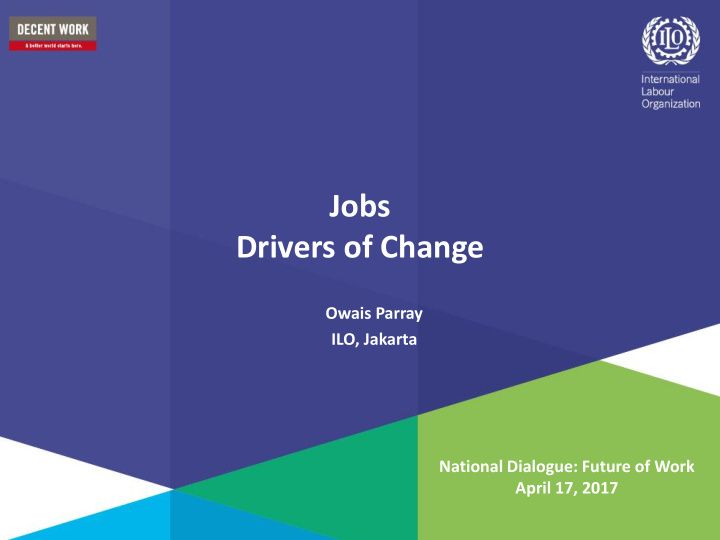



Jobs Drivers of Change Owais Parray ILO, Jakarta National Dialogue: Future of Work April 17, 2017
Outline 1. Drivers of economic growth & employment 2. New wave of creative destruction/ fourth industrial revolution 3. Impact in developed and developing countries 4. Looking at Indonesia 5. Way forward
Why are we talking about Future of Work?
Technology is engine of sustained economic growth Output = Capital + Labour
Economic diversification from subsistence agriculture to industry was key
Sector Breakdown GDP (2000 & 2015) 80 70 60 50 40 30 20 10 0 Agriculture 2000 Manufacture 2000 Services 2000 Manufacture 2015 Services 2015 Agriculture 2015 Source: World Bank Dbase accessed 6 April 2017
Employment share by sectors (2005 & 2015) 45% 40% 35% 30% 25% 20% 15% 10% 5% 0% 2005 (Nov) 2015 (Aug) Sumber: Sakernas, Aug Series 2005-2015
A large service sector in the economy and concurrent deindustrialization
Gig economy
In Indonesia proportion of workers having second job has increased 25.0 20.0 15.0 10.0 5.0 0.0 2016 2006 1996 15-24 25-34 35-44 45-54 55-64 65-98 15-98
More and more routine jobs are being replaced by automation
Product fragmentation
Share of national income for labour is declining
Impact of technology varies from developed to developing countries Developed Countries Developing Countries Some distance from technology Already more technologically frontier so adopting technology advanced so any further can complement labour, but it improvement can potentially could possibly lead to lead to job losses diminishing income
Absorption of technology in Indonesia • Recently there is more rapid technology uptake in trade & services (banking, logistics, transport etc.) • Less so in manufacturing and agriculture
Polarization of the labour market Decline of “routine/ mid - level” jobs Developing Countries Developed Countries -14% -12% -10% -8% -6% -4% -2% 0% Source: WDR 2016
Broad classification of occupations Managers Professionals Technicians and associate professionals Clerical support workers Service and sales workers Skilled agricultural, forestry and fishery Craft and related trades workers Plant and machine operators, and assemblers Elementary occupations
Unemployment by education (%) 20% 18% 16% 14% 12% 10% 8% 6% 4% 2% 0% No schooling ≤ Elementary School Junior High 1986 1996 2006 2016 Senior High Senior High (Vocational) Diploma University Average Unemp Rate Sumber: Sakernas 1986-2016
Trend in share of employment in Indonesia Are “routine/ mid - level” jobs growing slowly? Chart Title 45.0 40.0 35.0 30.0 25.0 20.0 15.0 10.0 5.0 - High skill cccupations Mid-level skill occupations Low skill occupations Agriculture work 2006 2016 Source: Sakernas, 2006 & 2016
Impact of technology in Indonesia Technology will reduce jobs Labour productivity Domestic sales Profits High-skill workers emp. Labour cost per worker Exports Total workers employed Women employed 0% 10% 20% 30% 40% 50% 60% 70% 80% 90% 100% Increase No impact Reduce Don’t know Source: ILO, 2015. ASEAN in transformation Survey
Unemployment rate has continued its downward trend, but that along does not capture the state of the labour market 12.00 10.00 8.00 6.00 4.00 2.00 - 2005 2006 2007 2008 2009 2010 2011 2012 2013 2014 2015 2016 Source: Sakernas, Augustus Series 2005-2016
Sumber: Sakernas, Aug 2016 10.0 0.0 1.0 2.0 3.0 4.0 5.0 6.0 7.0 8.0 9.0 BALI KEPULAUAN BANGKA BELITUNG DI YOGYAKARTA SULAWESI TENGGARA GORONTALO NUSA TENGGARA TIMUR SULAWESI TENGAH BENGKULU SULAWESI BARAT PAPUA Unemployment Provinces (%) NUSA TENGGARA BARAT JAMBI MALUKU UTARA JAWA TIMUR KALIMANTAN BARAT SUMATERA SELATAN LAMPUNG JAWA TENGAH SULAWESI SELATAN KALIMANTAN TENGAH SUMATERA BARAT KALIMANTAN UTARA KALIMANTAN SELATAN Average National SUMATERA UTARA DKI JAKARTA SULAWESI UTARA MALUKU RIAU PAPUA BARAT ACEH KEPULAUAN RIAU KALIMANTAN TIMUR JAWA BARAT BANTEN
Sumber: Sakernas, Aug 2016 10.0 15.0 20.0 25.0 0.0 5.0 BANTEN JAWA BARAT Employment in manufacturing by provinces (2016) JAWA TENGAH KEPULAUAN RIAU BALI JAWA TIMUR DI YOGYAKARTA KALIMANTAN UTARA DKI JAKARTA NUSA TENGGARA BARAT MALUKU UTARA SUMATERA BARAT LAMPUNG MALUKU KEPULAUAN BANGKA BELITUNG SULAWESI BARAT SULAWESI SELATAN SUMATERA UTARA RIAU GORONTALO SULAWESI TENGGARA NUSA TENGGARA TIMUR KALIMANTAN SELATAN KALIMANTAN TIMUR SULAWESI TENGAH ACEH SULAWESI UTARA KALIMANTAN BARAT SUMATERA SELATAN BENGKULU KALIMANTAN TENGAH JAMBI PAPUA BARAT PAPUA
Labour force by education attainment is showing positive trend University/Diploma IV Diploma III Diploma I/II Vocational High school Senior High school Junior High school Primary School or less 0.0 10.0 20.0 30.0 40.0 50.0 60.0 70.0 1996 2006 2016 Sumber: Sakernas, Aug Series 1996, 2006 & 2016
Rethink work and structural transformation • Traditionally manufacturing was the stepping stone for economic development • Deindustrialization is a worrying trend, especially developing countries without a mature manufacturing • Redefine work. Wasn’t technology supposed to give us more leisure time • Surplus from automization use to create more jobs; care, entertainment.
Technology is creating opportunities • New technologies can be transformative • Creating new opportunities and reducing costs even in low-income countries • Made individuals more autonomous and access to learning
Technological advances can be disruptive • Impact in developing and developing countries different • Jobs loses- squeezing the mid-skills level occupations
Steering the economy • An evidence-based approach should guide how policy-makers guide the economy • Regular collection and analysis of labour & economic data • Job matching platforms- there should be good feedback loop
Public investment in education & training • Positive externalities… and greater spillover effect • Lifelong learning to keep up with the changes in the labour market • Soft skills becoming very import
Expanding social safety net • Disruptions will invariably mean there are losers • Revisit social protection to ensure that vulnerable are not left behind • Universal basic income??
Terima kasih Owais Parray JAKARTA@ilo.org
Recommend
More recommend